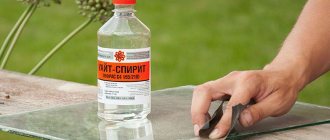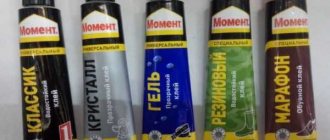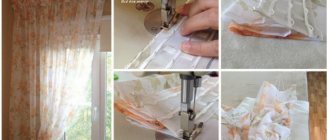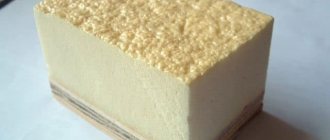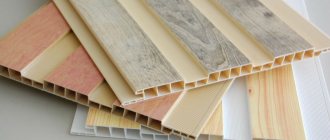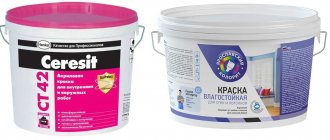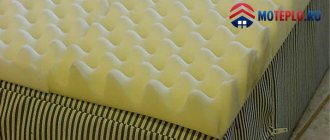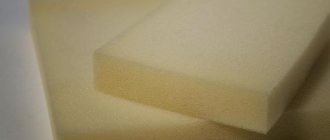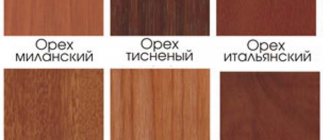Products made from polyurethane foam or based on it are presented in a wide range and are actively used in construction and home improvement, in the furniture and automotive industries. Let's look at polyurethane foam from a technical point of view: what it is, what properties it has. Let's get acquainted with the varieties of finished products and the characteristics of the final result of sprayed options. Read to the end and you will understand which type of polymer composition is best to choose to solve certain problems.
Foam rubber is a modification of polyurethane Source allegroimg.com
Definition
To better understand what polyurethane foam is, we will give a brief definition of the material - it is a synthetic foam with a cellular structure. Refers to a section of plastic filled with a special inert gas, and is often used in construction and manufacturing.
Among the undoubted advantages:
- • long-term use;
- • ease of operation;
- • minimal thermal conductivity;
- • excellent adhesion.
This is one of the high-quality insulation materials that is often used to improve the structural features of a house. Some surfaces are covered with gas-filled polyurethane foam of complex shapes. It has a long lifespan and is easy to use on construction sites.
Application
Let's look at polyurethane foam - what it is as a material for building and finishing a house. The main purpose of foam is insulation, sound insulation, sealing of local areas and installation gaps. Also, with the help of a liquid composition, various structural elements are secured: window sills, slopes, boxes and frames, drywall and panels.
Insulation of a window opening with polyurethane foam Source adgesia.ruhttps://m-strana.ru/articles/uteplenie-doma-iz-gazobetona/
Polyurethane foam (PPU), composition and properties
It is obtained by mixing two liquid materials:
- • polyisocyanate;
- • polyol.
The substance is whipped, when it hardens, then 90% of the frozen result turns out to be gas. This way the foam can be used for thermal insulation. It stops letting cold and heat through. The final product is structurally different, and the area of use is also different. This depends on the proportion of liquids and additives used.
This is how foam rubber is created - an elastic and soft filler. It is usually used as an interior part for furniture: sofas, armchairs and other upholstered products. The brand depends on two indicators - how dense and hard the foam is.
Density and hardness table
| Brand | Hardness level | How much can you load kg/cm2 |
| ST | Standard. | from 60 to 101 |
| H.L. | Hard. | from 80 to 121 |
| H.S. | Soft. | From 60 to 121 |
| EL | Increased rigidity. | From 60 to 101 |
| HR | Highly elastic. | From 100 to 121 |
| CMHR | Fireproof and highly elastic. | From 100 to 121 |
The presence of a fire retardant impurity turns polyurethane foam into rigid polyurethane foam. It has an increased density - from 30 to 85 kg/cm3. When it is ready, it loses its elasticity. But it has many other useful properties:
- • used to reduce noise levels and thermal insulation;
- • for insulation from foundation moisture, if it is above 70 kg/cm3.
For construction purposes, polyurethane foam is prepared from a couple of components:
- • Isocyanate is the basis of the chemical process, an unchanged component.
- • Polyol – varies depending on the purpose.
Such elements affect the reaction rate, how much foam it will foam, what the density and flammability will be in the end.
GOST 307302-2006 confirms that polyurethane foam has a G3 class - what is it: it is considered fire-resistant, self-extinguishing and flame-retardant.
Care
Caring for mattresses and other products with polyurethane foam padding is extremely easy. It is enough to rid the product of dust on the surface and periodically turn the mattress or pillow so that they do not lose their shape. Most often, manufacturers carefully equip the covers with fasteners, which makes it possible to remove them for washing.
Timely preventive measures will help maintain the original aesthetic appearance for a long time and save the user from unnecessary costs.
All of the above facts give reason to believe that the synthetic material is quite good and easy to use. Polyurethane foam can bring additional comfort to the everyday life of the average person. At the same time, you should not forget about the potential threat to health and weigh the pros and cons before you decide to purchase.
Advice! Try to purchase products from trusted manufacturers with a good reputation. Avoid products with suspiciously low prices. Remember that sleeping items are the key to health!
Varieties
Most enterprises can produce different types:
- • liquid – sold in spray containers;
- • hard – sheets, shells and panels;
- • foam rubber – mats and rolls of finished products.
Thickness and protective properties can vary depending on the purpose. The characteristics allow it to be prepared directly on the construction site. When the proportions of components change, the features change.
Foam rubber
It has a low density from 5 to 35 kg/m3. The scope of application is very wide - from furniture filler to linings in shoes and clothes, they are used to make washcloths and gaskets for doors and windows.
PPU hard
The main place of use is construction. More often it is produced directly on site - this saves resources. Using special equipment, workers mix the components in the required proportions.
This produces ready-made polyurethane foam, which is not afraid of petroleum products and water, but is afraid of organic solvents and other mineral acids. There are more than 30 brands of different purposes and densities. Polyurethane foam can be used in one form for insulation, or in combination with analogues of a different frequency.
The scope of application is wide - from noise and heat insulation of buildings to the insulating layer in refrigeration equipment. Extremely positive reviews.
Liquid
Used for spraying on walls and ceilings. Thanks to its thinner consistency, it became possible to spray it onto walls under pressure to provide insulation. Indispensable if you need to work without weighing down the structure.
Thickness table
| Name | Thickness, cm | ||||||
| 2,0 | 3,0 | 4,0 | 5,0 | 5,0 | 8,0 | 10,0 | |
| Uncoated/paper | 37,8 | 42,6 | 52,2 | 61,2 | 71,2 | 92,3 | 119,8 |
| Foil | 42,7 | 47,5 | 57,1 | 66,1 | 76,1 | 97,2 | 124,7 |
| Armofol | 37,5 | 41,2 | 49,3 | 56,8 | 65,0 | 82,6 | 105,5 |
| On one side - fiberglass | 51,6 | 56,4 | 66,0 | 59,8 | 68,0 | 85,6 | 108,5 |
Manufacturers
Polyurethane foam insulation has become popular recently. Therefore, new manufacturers of these products are appearing on the market, as well as contractor companies providing installation services.
Reputable PU foam suppliers produce components under their own brands. The rest, as a rule, are resellers, purchasing components from well-known brands. Some firms use local oil refineries.
Using consumer reviews, we can identify several reliable polyurethane foam manufacturers:
Basf
A German chemical concern with branches in 160 countries. The brand produces a wide range of products.
More than 7 thousand items, 60% of which are sold on the European market, about 22% of sales are in the United States of America, the rest is distributed between the markets of South America, Asia, Africa and the Pacific.
In Russia, the company has several subsidiaries, including BASF Construction Systems LLC, BASF Vostok LLC, Wintershall Russland. One of the well-known joint ventures producing polyurethane foam products is.
The company produces polyurethane systems that are available to consumers of any level and for various applications.
Synthesia International SLU
Spanish chemical company founded in 1964. The main direction since 1966 is the production of polyesters, as well as polyurethane systems for various industrial sectors, for example, thermal and acoustic.
Since 1970, polyurethane foam for sandwich panels, construction and refrigeration systems first appeared in the product range. Today the company produces products for different market segments.
The most famous distributor of products in Russia is Global Therm LLC.
This company provides direct deliveries, carries a certain supply of products in a warehouse in Moscow, guarantees a flexible payment system and consultations with technical specialists.
Sipur (Poland)
One of the largest manufacturers of sprayed polyurethane foam insulation.
Thermal insulation products are characterized by low thermal conductivity, which allows the insulation to be applied in a thinner layer (spray thickness up to 6 cm). The company guarantees a service life of polyurethane foam of about 50 years.
Polyurethane foam (PPU) technical characteristics and properties
In terms of thermal insulation characteristics, foam is superior to many analogues. As a heater it is difficult to find equal. High density and adhesion make the cold insulation capabilities even greater. They depend on the structure of the material. The liquid form has a coefficient of 0.019 to 0.035 W/m K, and the closest similar form, mineral wool, has a coefficient of 0.045 W/m K.
Vapor permeability is also low - closed cells do not let steam inside. For mineral wool, the same indicator is 50 times worse. Foam protects walls and ceilings from harmful influences, maintains the desired temperature inside the rooms and stops water particles from penetrating into the walls. But it is not recommended to use it under liquid or in direct contact with it, as this can cause a hydration reaction.
Comparison with mineral wool
This is the closest analogue, more popular, cheaper and inferior in a number of properties. The compressive strength of polyurethane foam is at the level of 0.3; for mineral wool it is not calculated, since it is a very flexible and obedient material.
Polyurethane foam can absorb no more than 10% of water; mineral wool is not designed for such a load and itself has a constant 4% humidity. It will not resist swelling from liquid, so it is not recommended to use it in residential buildings.
Let's talk about maximum service life. The foam will last at least 40 years, and the level of other substances does not exceed 10. Caked mineral wool simply becomes a harmful gasket that is of no use.
Polyurethane foam does not contain dangerous fumes, formaldehydes and phenols, like its cheaper analogue with 6% of unwanted compounds, and is completely safe. It is resistant to aggressive environments and has excellent resistance to rodents and insects. Polyurethane foam does not release fibers into the air; mineral wool contains an allergen for many people and azone-depleting gases.
Table: 12 characteristics
| Property | Index | Explanation |
| Density | 45-60 kg/m3. | Very light material, even mineral wool has 150-250. |
| Shrinkage | — | Was not identified. |
| Compressive strength | 0.46 mm/m. | An excellent indicator, foam concrete has a similar characteristic. |
| Heat conductivity | 0.021 W/m*K. | Mineral wool has 0.035 less than many analogues. |
| Frost resistance | Up to 1000 cycles. | Excellent feature. |
| Water absorption | 2%. | Better than analogues, foam concrete is up to 20%. |
| Vapor permeability | 0,001. | Almost complete insulation from steam, mineral wool has 0.29. |
| Fire resistance | 3G. | It goes out on its own and lights up poorly. |
| Price | 300-1800. | Depends on the thickness, presence and type of protective layers. |
| Sound isolation | High. | Higher than analogues. |
| Toxicity | Not considered toxic. | Can even be used in food refrigerators; there are no harmful fumes or dust. |
| How many years will it last | Up to 50. | It is considered one of the most durable types of insulation. |
Depending on the indicator they are divided:
- • C – self-damping;
- • Vehicles – difficult to burn;
- • TV – flame-resistant.
To increase fire resistance, special substances are usually added to the composition. It is important to know exactly which ones you can put, but it is better to entrust this to specialists rather than do it yourself.
Kinds
Experts distinguish three types of polyurethane foam:
Hard
This type of material has high density, hardness and lightness.
Thanks to these characteristics, it is used as acoustic or thermal insulation. Hard polyurethane foam looks like slabs. One of the applications is sandwich panels.
Beneficial features
Like any other material, foam has its advantages and disadvantages.
Advantages:
- • Lightness. Used in attics, roofs, light buildings. Doesn't make the structure heavy.
- • Does not require fastening elements or additional parts.
- • There are no “cold bridges”. Seamless thermal insulation.
- • Quick to apply. There is no need to prepare additionally or spend hours near the construction site.
- • You can work with the material at temperatures from -200 to +200 degrees.
- • Withstands changes in temperature and humidity, resistant to frost and heat.
- • Does not react to most alkalis, acids and salts.
- • Excellent surface grip.
In liquid form it is suitable for filling voids. Fills spaces between walls without dismantling ceilings - it simply pours into the hole.
Peculiarities
They are used very widely: rigid - as heat and sound insulation and lightweight form-building elements, elastic - as soft coverings and padding in everyday life and industry, as artificial sponges for washing and dust filters, material for paint rollers and inserts in garments, shock-absorbing package.
Self-foaming self-hardening compounds are popular for use directly on site in construction and mechanical engineering - both industrial multicomponent and household polyurethane foam.
Resistant to all common organic solvents, the frozen mixture can only be removed mechanically. In practical applications, protection from sunlight and other UV sources is required.
Compared to other foamed polymers used in limited areas - rigid polystyrene foam, elastic polyethylene foam, latex foam, microporous rubber, swelling cellulose sponge - the range of use of polyurethane foams is, as a rule, wider.
Minuses
Let's talk about what polyurethane foam looks like. It is a hardened foam with or without small pores, depending on the type of mixing. But it also has disadvantages:
- • Does not withstand constant exposure to ultraviolet radiation. It is necessary to protect from direct sunlight. The covering should be attached on top.
- • Apply only to dry and warm surfaces. Before application, the wall or floor should be cleaned of debris and rust to enhance adhesion.
Does not burn, but can smolder when exposed to high temperatures. Thermal insulation will deteriorate, so it is not recommended to use it in baths, saunas and stoves.
Release form
They produce ready-made polyurethane foam products for sound and thermal insulation in construction in the form of thin sheets, insulating boards, blocks, profiles of special configurations, fibers and bundles of different diameters and even films.
Products are foamed, reinforced with fibers or meshes - steel, fiberglass, polypropylene, laminated with film, foil, etc. Sheet polyurethane foam is produced.
In construction it is used as spraying and as finished materials for thermal insulation of industrial refrigerators, insulation of housing, administrative and industrial buildings, thermal insulation of pipeline systems, both from frost and heat.
PPU material: what is it for health?
When the foam has hardened and is in the wall, it does no harm. But during the production process, all safety requirements must be observed. You cannot mix components without:
- •masks;
- • respirator;
- • protective suit.
Helpful Tips:
- • reagents must be tested and certified;
- • place – not blown;
- • equipment – high quality.
If all conditions are met, the foam will be safe.
Sputtering process
If you have entered into an agreement with a company, a minibus arrives at the appointed time. It contains spraying equipment. To operate a high-pressure apparatus, a voltage of 380 V is required. If you only have 220 V, you usually start a generator that produces the required voltage. A low-pressure apparatus can operate from a 220 V network, but, as discussed below, the quality of thermal insulation will be significantly worse.
Typically, only hoses are pulled into or around the house to supply the foam components to the gun. It's comfortable. Workers who spray thermal insulation are dressed in protective suits, wearing a respirator, gloves and goggles. A respirator is necessary, since before hardening the components of the foam are toxic, and everything else is to protect the skin from ingress of polyurethane foam, which then cannot be removed.
The foam is applied from bottom to top, in small portions. Fill everything in without skipping, trying to prevent the formation of shells. As the foam expands, make sure that the layer thickness is no less than the required one. After the foam hardens, the excess can be cut off, but the deficiency cannot be made up for.
How to install
One of the most common methods is spraying. Using this method, the material holds well and is used economically; it is suitable for structures with complex geometry, protrusions and recesses. For the process to be successful, you need to:
- • Make sure that the wall or other surface is dry.
- • No high humidity, rain, hail or snow.
- • The wind does not exceed weak 5 m/s, and it is better to protect the work area from it.
- • Make sure that the coating area is warm - not lower than +10 degrees.
- • Heat the mixture - about +18-25 degrees at the time of application; cold is difficult to work with and does not hold well.
- • Apply a layer of no more than 3-5 cm, if thicker is required - in 2-3 steps after drying.
The room must be ventilated. The person should wear a special suit, mask and respirator. Start with difficult areas: pipes, convex or concave parts, ventilation hatches or electrical distribution boxes.
Helpful Tips:
- • It is recommended to apply the composition in several layers. This way the effect will be more significant and adhesion will be higher. It is important to ensure that the previous layer is completely dry. Especially significant on walls with signs of destruction. Here it will lie unevenly and will require 2-3 additional sprayings to even out the area.
- • Before purchasing, you should consult with a specialist to choose the right brand of polyurethane foam with the required impermeability. This will save money and time spent on repairs. You can purchase high-quality, high-strength material.
- • If you apply polyurethane foam taking into account all the requirements and advice, then a coating will appear on the surface that will last for many years and will perform its tasks until the end of its service.
This material is used to insulate the foundation and external walls if necessary. It is also used to treat main pipes to retain heat in them. Mounted on balconies and loggias, used inside toys and sponges for washing dishes. This is a large part of production, which is involved in various fields. It’s easy to purchase, and it’s easy to apply. The result is of high quality and retains its beneficial properties for many years if handled correctly.
Difference from foam rubber
Foam rubber is a soft sheet material. It is an elastic modification of polyurethane foam, air and moisture permeable. Gas occupies up to 90% of its volume. Foam rubber absorbs water well, which limits its use in construction. It is often used to insulate basements, pipelines, roofs, garages and so on. It is advisable to use it only for interior work.
The main difference between foam rubber and polyurethane foam is that the latter is a solid material and has a lower percentage of air bubbles. Thanks to this, they can insulate external structures.
Foam rubber is more often used in the production of sponges, paint rollers, for upholstery, and so on. Previously, it was widely used in the manufacture of mattresses. Such products had many disadvantages: they did not support the spine well and took the shape of the body.
Today it was replaced by PPU. Polyurethane foam mattresses can have varying degrees of hardness and are suitable for people with musculoskeletal diseases.
Flaws
But nothing is perfect, and in addition to many positive aspects, there are also some negative ones, namely:
- This is far from the most resistant material to ultraviolet radiation; it requires the use of a protective layer of plaster, covering with panels or painting.
- Use is limited to areas where there is excessive surface heating or a high risk of fire.
- When using spraying, the cost is quite high.
- Foam can only be applied to a warm and dry surface, which limits its use on an open construction site in winter.
Safety
A material is said to be environmentally friendly if only high-quality components and professional equipment were used when pouring the thermal insulation coating. It is equally important that the spraying is done by a qualified craftsman - how he mixes the components affects the safety of the coating. Raw materials for polyurethane foam belong to hazard classes 2 and 3, and after hardening, a material characterized by inertness is formed.
If the proportions of the starting components are chosen incorrectly or the technology for preparing the liquid mixture is violated, the chemicals will not react completely. The result is a pungent, toxic odor that does not dissipate well and causes illness. An experienced craftsman does not make mistakes, making the coating environmentally friendly and non-flammable.
During the mixing of raw materials, toxic formaldehyde, benzene, phenol and toluene diisocyanate are formed. After applying the “coat,” they evaporate within a day and are no longer released, unlike foam plastic or mineral wool. Opponents of the chemical compound focus on the destruction of the substance during the combustion process. They state that at a temperature of 180 ° C, ethylene, formaldehyde, nitrogen and carbon oxides, and isocyanates are released. In reality, such temperature conditions are not compatible with human life, so there is no need to talk about harm.
Moderately flammable, low-flammability material is characterized by low smoke-generating ability. Look at the photo with a charred but not burnt room. There was a fire on the top floor, but sprayed polyurethane foam contained the fire due to its low thermal conductivity and non-flammability. Not only hard compounds have such properties, but also high-quality soft ones. Sofas and pillows based on elastic polyurethane foam do not burn, do not emit harmful substances, do not cause allergies, and doctors do not prohibit their use. Cheap brands of foam rubber do not differ in such properties.
